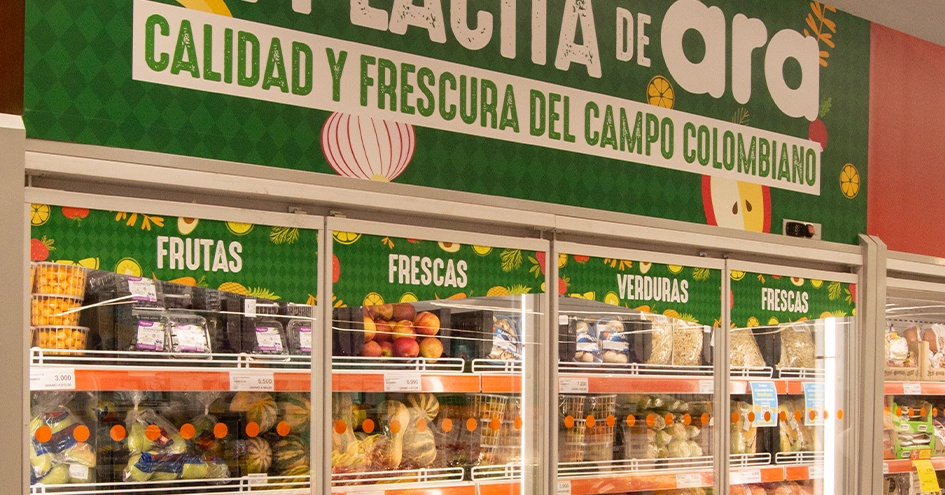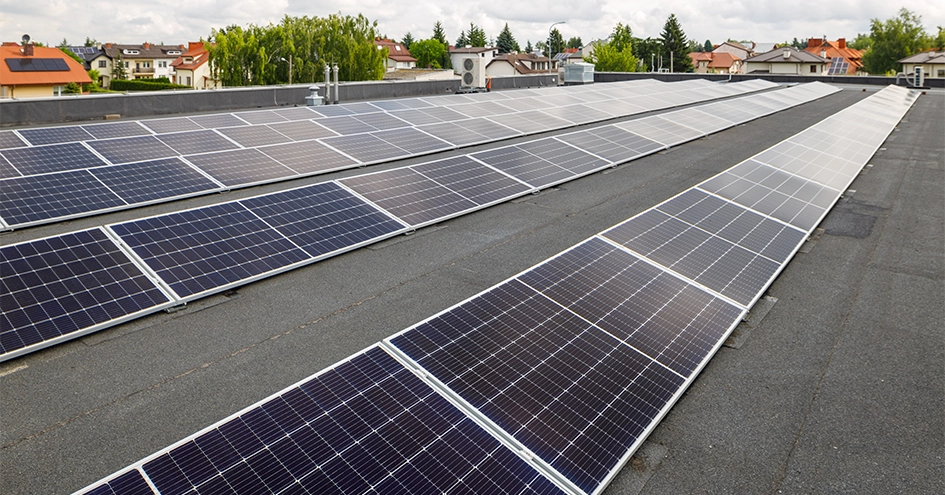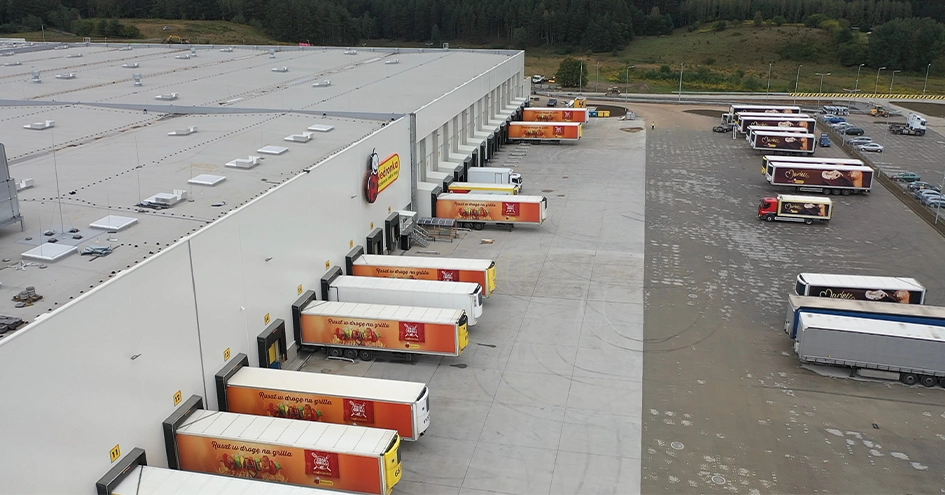As part of our Climate Transition Plan, we have implemented a series of actions aimed at reducing our carbon emissions:
- transition to natural refrigerant gases and those with low Global Warming Potential;
- investment in renewable energy sources and increased energy efficiency of our stores;
- transition from fossil fuels and increased logistics efficiency;
- promotion of a circular economy1.
Management of refrigerant gases

In our food distribution business, in which we stand out for the quality of our specialised perishables offering, refrigeration and air conditioning systems are of critical importance. These systems are vital to ensuring the quality, safety and preservation of food products, and play a decisive role in fighting food waste.
However, refrigeration systems and air conditioning consume energy and, in the event of a leak, also emit greenhouse gases. We invest in more efficient equipment precisely to reduce these effects. As part of the management of carbon emissions associated with the use of refrigerant gases in these systems, we have also installed leak control technologies and, where possible, we voluntarily opt for natural refrigerant gases in industrial refrigeration installations or those with low Global Warming Potential in heating, ventilation and air conditioning installations.
Establishments using natural refrigerant gases
|
|
Total |
|
Progress1 |
||||||||
|---|---|---|---|---|---|---|---|---|---|---|---|---|
Type of establishment |
|
2024 |
|
2023 |
|
2024 |
|
2023 |
||||
Stores – centralised refrigeration system |
|
3,439 |
|
2,953 |
|
57% |
|
52% |
||||
Stores – stand-alone equipment |
|
5,238 |
|
4,875 |
|
86% |
|
85% |
||||
Distribution centres and industrial units – centralised refrigeration system |
|
26 |
|
24 |
|
70% |
|
67% |
||||
|
||||||||||||
In 2024, the refrigeration systems of 70% of our distribution centres and industrial units, together with around 57% of those in stores were running on natural or low GWP refrigerant gases. Worthy of note is the investment in stand-alone refrigeration units, such as freezers, used in around 86% of our stores (3,489 at Biedronka, 1,404 at Ara, 305 at Pingo Doce, and 40 at Recheio).
Energy efficiency and renewable energies
We have implemented several good practices to reduce our carbon emissions associated with energy consumption. The refurbishment and new store opening plan includes solutions such as:
- technologies for generating renewable energy;
- energy control and management systems;
- refrigeration technologies and efficient freezers;
- efficient lighting.
Renewable Energy
|
|
Number of buildings |
|
Energy (GJ/year) |
|
Savings1 (t CO2e/year) |
||||||||||||||
|---|---|---|---|---|---|---|---|---|---|---|---|---|---|---|---|---|---|---|---|---|
Technology |
|
2024 |
|
2023 |
|
2024 |
|
2023 |
|
2024 |
|
2023 |
||||||||
Photovoltaic panels for |
|
2,101 |
|
779 |
|
295,776 |
|
113,901 |
|
35,567 |
|
15,772 |
||||||||
Pingo Doce2 |
|
36 |
|
26 |
|
48,820 |
|
29,475 |
|
2,287 |
|
1,880 |
||||||||
Recheio |
|
10 |
|
7 |
|
11,836 |
|
5,174 |
|
558 |
|
330 |
||||||||
Biedronka |
|
*1,804 |
|
728 |
|
202,420 |
|
68,887 |
|
31,604 |
|
13,050 |
||||||||
Ara |
|
249 |
|
16 |
|
26,307 |
|
4,591 |
|
818 |
|
143 |
||||||||
JMA |
|
2 |
|
2 |
|
6,393 |
|
5,774 |
|
300 |
|
368 |
||||||||
Lamp posts and security system powered by photovoltaic panels and/or wind turbines |
|
9 |
|
9 |
|
584 |
|
534 |
|
27 |
|
35 |
||||||||
Pingo Doce2 |
|
1 |
|
1 |
|
130 |
|
130 |
|
6 |
|
8 |
||||||||
Recheio |
|
5 |
|
5 |
|
439 |
|
258 |
|
21 |
|
17 |
||||||||
Biedronka |
|
1 |
|
1 |
|
10 |
|
10 |
|
0.4 |
|
2 |
||||||||
JMA |
|
2 |
|
2 |
|
6 |
|
136 |
|
0.3 |
|
8 |
||||||||
Solar collectors to produce hot water used for heating water and/or in the air conditioning system |
|
16 |
|
17 |
|
3,952 |
|
4,020 |
|
185 |
|
256 |
||||||||
Pingo Doce2 |
|
7 |
|
7 |
|
3,399 |
|
3,399 |
|
159 |
|
217 |
||||||||
Recheio |
|
7 |
|
8 |
|
489 |
|
552 |
|
23 |
|
35 |
||||||||
JMA |
|
2 |
|
2 |
|
64 |
|
69 |
|
3 |
|
4 |
||||||||
Geothermal heat pumps (Biedronka) |
|
20 |
|
15 |
|
4,467 |
|
5,884 |
|
697 |
|
1,115 |
||||||||
|
||||||||||||||||||||

In 2024, we invested heavily in the installation of photovoltaic panels for self-consumption, particularly in Poland and Colombia. The investments ensured the generation of around 305 thousand GJ, 145% more than in 2023. Since July 2018, we have been investing in electricity from renewable energy sources to power the operations of our banners in Portugal, by purchasing Guarantees of Origin (GO). In 2024, this investment in photovoltaic panels, GO and other renewable energy technologies avoided the emission of 120 thousand tonnes of carbon dioxide equivalent, while Biedronka, through a Virtual Purchase Power Agreement (VPPA), guaranteed the production of 226 thousand GJ of photovoltaic solar energy and avoided the emission of 35,300 tonnes of carbon dioxide equivalent.
Raising employee awareness of waste recovery and the efficient use of water and energy has also helped improve the environmental performance of our establishments. The “Water and Energy Consumption Management Teams” project, launched in 2011 in the Pingo Doce and Recheio stores, has helped to reduce water consumption by 493 thousand m3 and energy consumption by 119 thousand MWh, corresponding to an accumulated savings of over 13.8 million euros2. At Pingo Doce, the actions of these teams are part of the “Todos pelo Ambiente” (Everyone for the Environment) initiative. Biedronka continued its “Dobra energia” (Good Energy) project, launched in 2022, which included the development of a good practice handbook to save energy in stores, interactive training for all store employees, energy monitoring reports, and a dedicated chatbot to facilitate daily store operations. The “Let’s Go Green” project, implemented in 2015 with the same goal, encompasses office buildings in Portugal, Poland and Colombia.
We have invested over 690 million euros in energy efficiency, renewable energy production for self-consumption and low GWP refrigerant gases since 2017, around 300 million of which in the past two years, underscoring our reinforced focus on reducing energy consumption and carbon emissions. Our average recovery period is three years and has already avoided the emission of more than 1.1 million tonnes of CO2e.
In the coming years, and in order to achieve our short-term scope 1 and 2 targets, we plan to invest an average of at least 10% of CapEx each year. Investments related to on-site production and the purchase of renewable energy through Guarantees of Origin, Power Purchase Agreements and Virtual Power Purchase Agreements, will continue to grow and represent a higher percentage of operating expenses. Additional information on the CapEx associated with these activities is provided in “Disclosures pursuant to Article 8 of Regulation (EU) 2020/852 (Taxonomy Regulation)”.
Fossil fuels and increasing logistics efficiency
Our plan to reduce carbon emissions associated with the consumption of fossil fuels in operations and logistics involves:
- increasing the number of electric and/or plug-in hybrid vehicles in our fleet and increasing the use of biofuels and hydrogen;
- progressively reducing the use of fossil fuels in operations through the electrification of equipment and/or the use of biofuels;
- improving the efficiency of logistics processes.

In 2024, approximately 12% of our light vehicle fleet in Portugal and 1% in Poland was electric or hybrid, in line with 2023 (11% in Portugal and 1.5% in Poland).
We are optimising distribution routes – via backhauling3 and fronthauling4 – and increasing investment in more efficient trucks to improve the efficiency of logistics processes.
Backhauling operations
Thousands of km avoided
Emissons avoided
(t CO2e)
In 2024, backhauling operations shaved off 45.8 million kilometres, 40% more than in 2023, with the respective reduction in emissions (35,800 tonnes of carbon dioxide equivalent). In Colombia, backhauling is practically non-existent due to the lack of space on trucks to increase reverse logistics. In addition, suppliers are not close to the return routes.
The fronthauling project shaved off around 150,000 km (2.7% more than in 2023) and avoided the emission of 132 tonnes of carbon dioxide equivalent at Pingo Doce and Recheio.
At Ara, the project to transport non-palletised goods to optimise transport loads between our suppliers’ facilities and our distribution centres shaved off over one million kilometres (73.0% more than in 2023) and avoided the emission of 1,734 tonnes of carbon dioxide equivalent. The by-truck project (extra trailers for the transportation of goods between distribution centres and the farthest stores) shaved off 2 million kilometres, 1.4% less than in 2023, and consequently avoided the emission of 1,609 tonnes of carbon dioxide equivalent.
Breakdown of goods transport vehicles according to the Euro standards
In 2024, more than 95% of the vehicles we use for transporting goods were Euro V or VI trucks, an increase of 5 p.p. compared to 2023. We also registered the additional use of Euro VI trucks (256 more than in 2023), while Colombia increased its fleet of Euro V and Euro IV trucks (51 more trucks).
In 2024, carbon emissions (per thousand pallets) associated with the transport of goods to stores decreased 6.1% compared to 2021, the base year. Our goal is to reduce carbon dioxide equivalent emissions by 5%, per thousand pallets transported, by the end of 2026, compared to 2021.
Carbon emissions associated with pallet transport
|
|
2021 |
|
2023 |
|
2024 |
|---|---|---|---|---|---|---|
Transport of goods to stores (km) |
|
249,551,570 |
|
265,523,690 |
|
263,407,687 |
Transport of goods to stores (t CO2e) |
|
205,375 |
|
220,058 |
|
214,794 |
Carbon emissions from transporting goods to stores, per 1,000 pallets transported |
|
5.57 |
|
5.40 |
|
5.22 |
Decarbonising logistics
JMA’s dairy company Terra Alegre was awarded its first Lean & Green star in 2024 for its logistics decarbonisation plan, which saw CO2e emissions from its logistics operations reduced by 23.4% in 2023 compared to 2022
Pingo Doce, which joined Lean & Green in 2021, is the first company in Portugal and the fourth in Europe to achieve the four stars. Conquered in 2024, this recognition is the result of a 55% reduction in carbon dioxide equivalent emissions (tCO2e/pallet) in its logistics operations in mainland Portugal, compared to 2018.
Biedronka, which also joined the Lean & Green initiative in 2021, had already received a star in 2022, as a result of a 20% reduction in emissions from logistics activities in eight of its distribution centres between 2017 and 2020. In 2024, Biedronka was awarded a second Lean & Green star after reducing carbon emissions by a further 12% in logistics activities between 2021 and 2023. To receive the second star, Biedronka had three years to demonstrate that it was able to maintain a 20% reduction in GHG emissions and achieve a further 10% reduction in CO2e within three years, covering 12 out of its 17 distribution centres, equivalent to at least 65% of the volume transported, according to the programme’s criteria.
Lean & Green is a European initiative that aims to achieve carbon neutrality in logistic activities by 2050.
1 Information about our actions to promote a circular economy can be found in “Resource use and circular economy”.
2 Value calculated based on regular internal benchmarking reports, from which the stores refurbished in 2023 and 2024 were excluded because consumption was not comparable.
3 After delivering products to our stores, the return route includes stopping by the facilities of the Group’s suppliers to pick up goods and take them to the distribution centre.
4 After delivering products to our distribution centres, our suppliers’ return route to their facilities includes stopping by the Group’s stores to deliver goods. This project is only implemented in Portugal.
